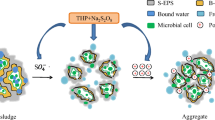Abstract
Based on the analysis of the properties of oily sludge samples, the effect of modification parameters, such as liquid to solid (L/S) ratio, agitation temperature, agitation intensity, agitation time and pH on the modification of oily sludge was investigated with the content of oil remnants in dry sludge as a reference index. Remixing experiments were carried out according to a simplex-lattice design, where Sx4056 was used as the demulsifier, petroleum sulfonate as the surfactant and sodium silicate (Na2SiO3) as the dispersant. The surface modification reagent formulation was optimized by a regression equation on the modified effect and based on the amounts of surface modification reagents. The results show that the content of the oil remaining in dry oily sludge is 0.28% of 10.15% oily sludge, when the reagent concentration rises to 3.5 g/L under the optimum experimental conditions.
Similar content being viewed by others
References
LIU Tian-qi. Petrochemical environmental protection handbook [M]. Beijing: Carbonhydrogen Processing Press, 1990. (in Chinese)
ZHOU Ling-sheng, JIANG Xiu-min, LIU Jian-guo. Characteristics of oily sludge combustion in circulating fluidized beds [J]. Journal of Hazardous Materials, 2009, 170(1): 175–179.
BENGTSSON A, QUEDNAU M, HASKÅ G, NILZÉN P, PERSSON A. Composting of oily sludge degradation stabilized volatiles and microbial activity [J]. Waste Manage Res, 1998, 16(3): 273–284.
NAKHLA G, AL-SABAWI M, BASSI A, LIU V. Anaerobic treatability of high oil and grease rendering wastewater [J]. Journal of Hazardous Materials, 2003, 102(2/3): 243–255.
MILNE B J, BAHERI H R, HILL G A. Composting of a heavy oil refinery sludge [J]. Environmental Progress, 1998, 17(1): 24–27.
ESSAM A H Z, DANA M A. Fuel recovery from waste oily sludge using solvent extraction [J]. Process Safety and Environmental Protection, 2010, 88(5): 318–326.
XU Ning, WANG Wen-xiang, HAN Ping-fang, LU Xiao-ping. Effects of ultrasound on oily sludge deoiling [J]. Journal of Hazardous Materials, 2009, 171(1/2/3): 914–917.
OLAJIRE A A, ALTENBURGER R, KÜSTER E, BRACK W. Chemical and ecotoxicological assessment of polycyclic aromatic hydrocarbon-contaminated sediments of the Niger Delta, Southern Nigeria [J]. Sci Tot Environ, 2005, 20: 123–136.
CALVO C, TOLEDO F L, GONZÁLEZ-LÓPEZ J. Surfactant activity of a naphthalene degrading Bacillus pumilus strain isolated from oil sludge [J]. Journal of Biotechnology, 2004, 109(3): 255–262.
ROSHNI M, RICHARD A D. Gas attachment of oil droplets for gas flotation for oily wastewater cleanup [J]. Separation and Purification Technology, 2003, 33(3): 303–314.
RAMASWAMY B, KAR D D, DE S. A study on recovery of oil from sludge containing oil using froth flotation [J]. Journal of Environmental Management, 2007, 85(1): 150–154.
HE De-wen, XIAO Yu-tang, LI Xiong, JIN Yan. Treatment of oil/water emulsion by polyethylene glycol ultrafiltration membrane [J]. Journal of Central South University of Technology, 2005, 12(5): 542–545.
BJÖRN J, ROBERT J P, ALEXANDROVA L. Flotation de-inking studies using model hydrophobic particles and non-ionic dispersants [J]. Colloids and Surfaces A: Physicochemical and Engineering Aspects, 2000, 170(2/3): 217–230.
LI Yi-chuan, WANG Dong, WANG Yu, SUN Jun-xiang. Study on process conditions of oil sludge washing and petroleum retrievement by thermochemical washing [J]. Environmental Pollution and Control, 2008, 30(3): 39–42. (in Chinese)
HE Ze-neng, LI Zhen-shan, JI Gong-dong. Experiment of oil recovery from oil-contaminated soil [J]. Journal of Basic Science and Engineering, 2005, 13(2): 136–145. (in Chinese)
LUO Shi-ping, ZHOU Gong-ping, ZHANG Qi. Study on process condition of treatment of petroleum-contaminated soil [J]. Journal of Jiangsu Polytechnic University, 2005, 13(1): 24–26. (in Chinese)
PANG Xiao, ZHANG G.ang, LI Liu-ren, GAO Tian-hao, WANG Wei-gang. The study on mechanism and optimization of parameter for the treatment of oily sludge by hot washing method [J]. Chemical Engineering of Oil and Gas, 2009, 38(1): 85–88. (in Chinese)
TONG Lei, WEI Chang-hua, ZHAO Zhong-yi. Research of the treatment of oily sludge by surface preprocessing and hot washing method [J]. Anhui Chemical Industry, 2005, 31(5): 45–47. (in Chinese)
AHMADUN F R, ALIREZA P, LUQMAN C A, DAYANG R A B, SAYED S M, ZURINA Z A. Review of technologies for oil and gas produced water treatment [J]. Journal of Hazardous Materials, 2009, 170(2/3): 530–551.
YANG Chen-lu. Electrochemical coagulation for oily water demulsification [J]. Separation and Purification Technology, 2007, 54(3): 388–395.
PEARSE M J. An overview of the use of chemical reagents in mineral processing [J]. Minerals Engineering, 2005, 18(2): 139–149.
MUHANNAD J, PETER K, BERND W M. Physicochemical properties and hemolytic effect of different lipid emulsion formulations using a mixture of emulsifiers [J]. Pharmaceutica Acta Helvetiae, 1999, 73(6): 293–301.
GAO Yan, WANG Yu-qiang, MA Yu-kun, YU Ai-hua, CAI Feng-qun, SHAO Wei, ZHAI Guang-xi. Formulation optimization and in situ absorption in rat intestinal tract of quercetin-loaded microemulsion [J]. Colloids and Surfaces B: Biointerfaces, 2009, 71(2): 306–314.
Author information
Authors and Affiliations
Corresponding author
Additional information
Foundation item: Project(50974119) supported by the National Natural Science Foundation of China; Project(2006A019) supported by the Science and Technology Fund of China University of Mining and Technology
Rights and permissions
About this article
Cite this article
Li, Xb., Liu, Jt., Xiao, Yq. et al. Modification technology for separation of oily sludge. J. Cent. South Univ. Technol. 18, 367–373 (2011). https://doi.org/10.1007/s11771-011-0705-7
Received:
Accepted:
Published:
Issue Date:
DOI: https://doi.org/10.1007/s11771-011-0705-7




